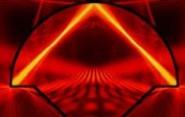Optical Mushroom: A New Trick for Directional Emission

10/12/2009
Departments: Applied Physics, Electrical & Computer Engineering
Yale researchers have found a new way to efficiently direct the light emitted from an optical microcavity for potential application in integrated photonic circuits, microlasers, and cutting-edge on-chip devices for communications.
Much like a whispering gallery, where a person’s whisper can be clearly transmitted to other parts of a vast elliptical or circular gallery space by bouncing off of the walls, light can be efficiently confined through internal reflection – albeit in cavities much, much smaller in size.
The price of efficiently trapping light, however, is usually isotropic emission – meaning a small amount of light is lost equally in all directions. This makes extraction and collection of the light inefficient and, therefore, limits the usefulness of such small devices in the design of lasers and other technologies.
As featured on the cover of the October 9, 2009, issue of Physical Review Letters, in collaboration with Adilson Motter, professor of physics and astronomy at Northwestern University, professor of applied physics, Hui Cao, has found a new way to direct or concentrate the emission of light using a mushroom-shaped optical microcavity. According to lead author, Jonathan Andreasen, the mushroom cavity employs a new trick for increasing the emission of light in two directions while reducing it in all others.
Other researchers have explored methods for creating such directional emission, such as deforming circular microcavities to make the cavities themselves directional. The novel approach demonstrated by Yale researchers in this study allows the light to escape the cavity, only to be subsequently forced to re-enter and directed toward specific points, from which it can be refracted or emitted from the cavity (see figure).
While the applications for this research are yet to be tested, Cao acknowledges that this is an important and intrinsically appealing new effect in optical physics.

